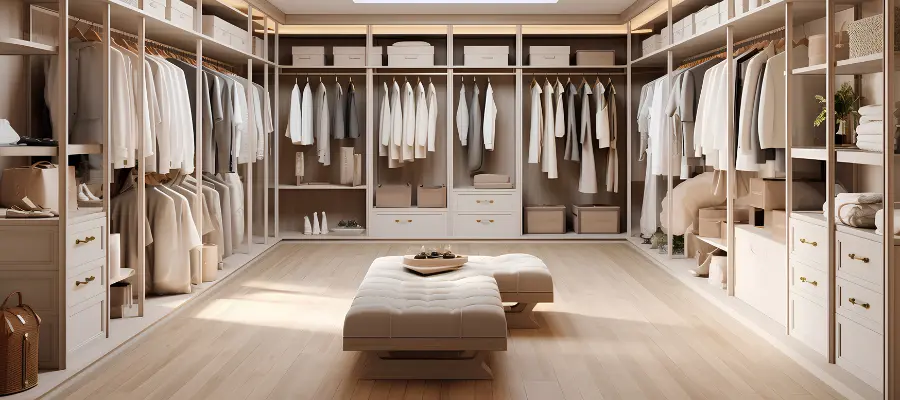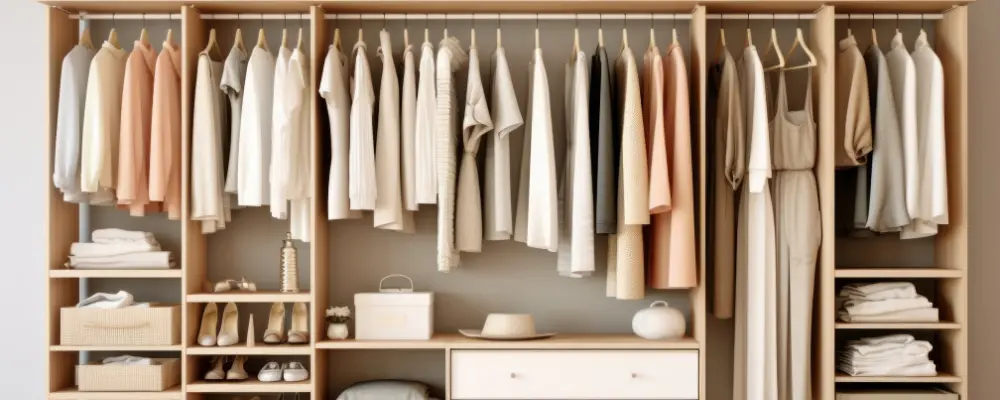The internal planning of a wardrobe revolves around a combination of hanging closets, drawers, and shelves, which are used for keeping clothes, accessories, jewelry, shoes, and more. A well-organized internal wardrobe layout is crucial for ensuring a clutter-free look and making efficient use of every inch of space. Before ordering a new wardrobe, it is essential to make a list of your requirements, including the number of drawers and shelves and the amount of space needed for hanging clothes, so that they can be incorporated into the design.
Here are the key dimensions and tips that will help you create the perfect wardrobe for your needs.
Hinged Wardrobe
Hinged wardrobes have front doors fixed with simple hinges and are one of the most traditional wardrobe designs.
Key Dimensions:
- Depth: The standard depth of a hinged wardrobe is 24 inches. If your room is short on space, you can opt for a depth of 22 inches; however, this depth is not ideal for hanging clothes.
- Height: The height of the wardrobe should either match the lintel level of the doors, usually 84 inches, or you can create a full-height wardrobe by using the space from the floor to the ceiling.
- Width of Door Panels: The door panel of a single-door or double-door wardrobe should not exceed 24 inches in width to avoid putting too much load on the hinges.
Hinged wardrobes are versatile and can be customized with various internal layouts to suit different storage needs. They provide easy access to all sections of the wardrobe simultaneously, which is a significant advantage over sliding wardrobes.
Sliding Wardrobe
Sliding wardrobes are a modern and space-saving alternative to hinged wardrobes. They comprise front panels that slide on tracks, which makes them ideal for small rooms where space is a premium.
Key Dimensions:
- Depth: The depth of a sliding-door wardrobe should be 26 inches, which includes a running track of about 2 inches to allow free movement of the sliding panels and prevent clothes from getting stuck.
- Minimum Length: The minimum length (left to right) of a sliding-door wardrobe should be at least 7 feet to accommodate two door panels of 3.5 feet each. This allows you to access each of the 3.5-foot-wide openings of the wardrobe one at a time.
- Width of Panels: The width of each panel of a sliding wardrobe should not exceed 4 feet to ensure the panels are not too heavy and can slide easily.
Sliding wardrobes offer a sleek, contemporary look and are particularly useful in rooms with limited space and loft space. They can be customized with a variety of internal configurations, including shelves, drawers, and hanging rails.
Men’s Wardrobe
A men’s wardrobe should be designed with specific storage requirements in mind, such as hanging rails for shirts and coats, and ample drawer space for accessories and smaller items.
Key Dimensions:
- Hanging Rails: Introduce two hanging rails for shirts by dividing the wardrobe vertically into two equal sections, each with a minimum height of 40 inches. Ensure there is a minimum space of 3 inches between the rail and the top of the wardrobe for easy removal and replacement of hangers.
- Depth for Coats: A wardrobe dedicated to coats should have a depth of 28-30 inches to accommodate the wider sleeves of coats without them getting stuck in the door panels.
In addition to hanging space, consider including drawers of varying depths for items such as ties, belts, and other accessories.

Women’s Wardrobe
Women’s wardrobes typically need more vertical space for hanging long dresses, gowns, and sarees, as well as shelves for folded clothes and accessories.
Key Dimensions:
- Hanging Long Clothes: For hanging long dresses and gowns, the vertical clearance should be 66-72 inches, adjusted according to individual height and requirements.
- Hanging Shorter Clothes: For hanging sarees or formal shirts, a height of 40 inches is sufficient.
- Shelves: Introduce open shelves for keeping folded clothes, with a clearance of at least 12-15 inches between each shelf.
Including a mix of drawers and shelves can help keep accessories, jewelry, and other items organized and easily accessible.
Child’s Wardrobe
Children’s wardrobes require careful planning to accommodate their specific needs, such as lower hanging rails and drawers for toys and accessories.
Key Dimensions:
- Hanging Rails: Divide the vertical length of the wardrobe into three sections of about 28 inches each, which is ideal for hanging clothes for kids and toddlers.
- Drawers: Include drawers ranging from 6 to 15 inches in depth to accommodate accessories, books, and toys.
- Shelves: Opt for open shelves spaced 12 inches apart for shoes, folded clothes, and towels.
A well-organized child’s wardrobe can help instill good habits and make it easier for children to find and put away their clothes and belongings.
Walk-in Closet
A walk-in closet offers ample space and flexibility for organizing clothes, shoes, and accessories. Proper planning is essential to make the most of this luxury space.
Key Dimensions:
- Clearance: If there are wardrobes on both (opposite) sides of the closet, maintain a clearance of about 54-60 inches between the facing wardrobes to ensure enough space to pass by even if one wardrobe door is open. If there is a wardrobe only on one side of the wall, ensure a clearance of at least 3 feet in front of the wardrobe.
- Sliding Panels: For narrow walk-in closets, consider using sliding panel wardrobes as a space-saving solution.
Walk-in closets can be customized with a variety of storage solutions, including shelves, drawers, and hanging rails, to create an organized and luxurious dressing area.
Wardrobe Drawers
Drawers are a vital component of any wardrobe, providing easy access to smaller items and keeping the wardrobe neat and organized.
Key Dimensions:
- Multi-purpose Drawers: The common depth for multi-purpose drawers is around 8 inches, suitable for storing clothes, accessories, and other items.
- Accessory Drawers: For accessories such as belts, ties, and jewelry, consider drawers with a depth of 4-6 inches.
Including a variety of drawer depths ensures that all items can be stored efficiently and accessed easily.
Shoe Shelves
Shoe shelves are an essential part of a well-organized wardrobe, ensuring that shoes are easily accessible and neatly stored.
Key Dimensions:
- Height: Allow a height of 6-7 inches for each shoe shelf, enough for high-heeled sandals, flat shoes, and running shoes. For storing long boots, opt for a section with a height of around 18-20 inches.
- Depth: The depth of shoe cabinets should be approximately 15 inches.
Proper shoe storage helps maintain the condition of your footwear and keeps your wardrobe looking tidy.
Additional Considerations
When designing your wardrobe, consider the following additional elements to enhance functionality and aesthetic appeal:
- Cupboard for Clothes: Ensure that your wardrobe includes ample cupboard space for hanging clothes.
- Wooden Cupboard for Clothes: Wooden cupboards are durable and provide a classic look to your wardrobe.
- Wardrobe Design: A well-thought-out wardrobe design can make a significant difference in how organized and functional your storage space is.
- Small Cupboard for Clothes: Incorporate small cupboards for specific items like accessories or seasonal clothes.
- Kapde Rakhne Ki Almari: Ensure there is enough space for storing all types of clothes, including traditional attire.
- Internal Wardrobe Dimensions: Pay close attention to the internal dimensions to ensure every item has its designated space.
Conclusion
Creating the perfect wardrobe involves careful planning and consideration of your specific storage needs. By understanding the key dimensions and incorporating a mix of hanging rails, shelves, and drawers, you can design a wardrobe that maximizes space and ensures a clutter-free, organized look. Whether you choose a hinged, sliding, or walk-in wardrobe, these tips and dimensions will help you make efficient use of every inch of space, providing a functional and aesthetically pleasing storage solution.

